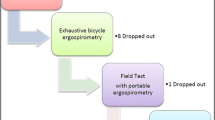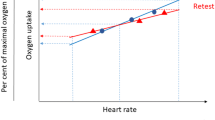Summary
Oxygen consumption and heart rate have been measured by 47 workers of a motor car factory. 20 were also investigated in the laboratory in order to determine on the bicycle ergometer the same parameters at different loads and the individual aerobic power. The advantages of telemetry for the measurement of heart rate are presented. The relationf h/\(\dot V_{O_2 }\) is quite the same at work and on the ergometer. Consequently, it is possible to use the heart rate only to measure the energy expenditure at work by these industrial workers. Is is possible to determine on the ergometer the load equivalent to the industrial work. In this case, the equivalent load is about 75 watts (\(\dot V_{O_2 }\) between 800 and 1260 ml/min.). In peak activity, our workers need no more than 55% of their aerobic power and no more than 78% of their maximal heart rate. During a working period of 3 hours, obviously with resting periods, the workers use about 58% of their maximal heart rate and about 24% of their aerobic power. The importance of the percentage of aerobic power and of maximal heart rate used at rest should be taken into account for the interpretation of the results. In our study each worker able to perform 75 watts with a heart rate lesser than 78% of his maximal heart rate and with an oxygen uptake lesser than 55% of his aerobic power should be considered fit for this industrial work. The utilization of the basal heart rate as proposed byHettinger seems us inaccurate and obviously inadequate for rehabilitation of cardiac and pulmonary patients. The study of energy expenditure during occupational work requires further investigations in order to know what percentage of the aerobic power can be allowed during a 8 hours continuous activity in other jobs. The importance of peak works frequency needs further studies.
Similar content being viewed by others
Bibliographie
Asmussen, E., andM. Nielsen: Cardiac output during muscular work and its regulation. Physiol. Rev.35, 778 (1955).
Åstrand, I.: Aerobic work capacity in men and women with special reference to age. Acta physiol. scand. Suppl.169 (1960).
Barnes, R.: L'étude des mouvements et des temps. Paris: Ed. d'organisation 1960.
Benedict, F. G., andV. C. Myers: The determination of creatine and creatinine. Amer. J. Physiol.18, 397 (1907).
Bengtsson, E.: The working capacity in normal children evaluated by submaximal exercise on the bicycle-ergometer and compared with adults. Acta med. scand.154, 91 (1956).
Bonjer, F. H.: Fysiologische methoden voor het vaststellen van belasting en belast-baarheid. Assen: Van Gorcum & Co. N. V. 1965.
Boothby, W. M.: A determination of the circulation rate in man at rest and at work. The regulation of the circulation. Amer. J. Physiol.37, 383 (1915).
Bouisset, S., H. Monod etD. Henon: Etude d'un travail musculaire léger par la mesure de la fréquence cardiaque. Trav. Humain25, 51 (1962).
Brouha, L.: Physiologie et Industrie. Monographie de Physiologie causale. III. Paris: Gauthier-Villard 1963.
Brown, J. R.: Standards and scales of energy requirements for industrial workers. Bull. Hyg. (Lond.)40, 586 (1964).
Christensen, E. H.: Beiträge zur Physiologie schwerer körperlicher Arbeit: Die Pulsfrequenz während und nach schwerer körperlicher Arbeit. Arbeitsphysiologie4, 453 (1931).
Christensen, E.: L'homme au travail. Etude succinte de physiologie appliquée aux conditions de travail dans un pays sub-tropical. Secur. Hyg. et Med. Trav. 1964, n °4, BIT.
Degre, S., R. Messin etH. Denolin: Enregistrement à distance de la fréquence cardiaque et de l'électrocardiogramme. Quelques aspects techniques de la télémétrie. Acta cardiol. (Brux.)21, 588 (1966).
Denolin, H., M. Rogowsky, S. Degre etR. Messin: Confrontation entre les besoins énergétiques des postes de travail et les tests d'aptitude cardiaque. Rev. Sem. Belges Réadap.8, 47 (1966).
Durnin, J. V., andR. Passmore: Energy, work and leisure. London: Heinemann Educational Books 1967.
Haldane, J. S., andJ. I. Graham: Methods of air analysis. London: Griffin 1935.
Harris, J. A., and F. G.Benedict: A biometric study of basal metabolism in man. Carnegie Institution of Washington, 1919.
Hettinger, T. H.: Rationalisierte Arbeitsgestaltung aus der Sicht des Arbeitsmediziners. Tz. f. prakt. Metallbearb.60, 349 (1966).
Lehmann, G.: Praktische Arbeitsphysiologie. Stuttgart: Thieme 1953.
- Recherches sur la physiologie du travail dans l'industrie lourde. Etude du travail n ° 107, Mai 1960.
—: La mesure des temps alloués. Louvain: Librairie Univers. 1965.
Maze-Sencier, R.: Pratique du chronométrage. Paris: Ed. d'organisation 1960.
Messin, R., andS. Degre: Respiratory gas analysis. Med. thor.23, 339 (1966).
—,H. Denolin etS. Degre: Etude d'un test simple d'aptitude à l'effort: la C.T. 170. Arch. Mal. Coeur3, 305 (1965).
Passmore, R., andJ. V. Durnin: Human energy expenditure. Physiol. Rev.35, 80 (1955).
Robinson, S.: Experimental studies of physical fitness in relation to age. Arbeitsphysiologie10, 251 (1938).
Rogowsey, M.: Etude des variations de consommation d'oxygène et de fréquence cardiaque à différents postes de travail dans une usine d'assemblage automobile en corrélation avec un test d'aptitude physique à l'effort (cyclergomètre). Arch. belges Méd. soc.1, 1 (1967).
Sjöstrand, T.: Changes in the respiratory organs of workmen at an ore smelting works. Acta med. scand.196, 687 (1947).
Spitzer, H., etTh. Hettinger: Tables dormant la dépense énergétique en calories pour le travail physique. Paris: Cahiers du BTE 1966.
Tarriere, C., R. Rebiffe etM. Pottier: Utilisation chez l'homme d'un télécompteur de fréquence cardiaque. Trav. Humain3, 239 (1964).
Vogt, J. J.: Analyse des effets conjoints du travail musculaire et de la contrainte thermique sur la fréquence cardiaque et la température rectale. Exposés du IIe Congrès Soc. Ergonomie Langue Franç. Bruxelles 1964.
Wahlund, H.: Determination of the physical working capacity. Acta med. scand. Suppl. 215 (1948).
Wyndham, C. H., C. G. Williams, J. F. Morrison, andM. Watson: The maximum oxygen intakes of men working on industrial tasks. Int. Z. angew. Physiol.22, 141 (1966).
Author information
Authors and Affiliations
Additional information
Ce travail a été réalisé avec l'aide financière de la Communauté Européenne du Charbon et de l'Acier.
Rights and permissions
About this article
Cite this article
Degre, S., Rogowsky, M., Vandermoten, P. et al. Etude pratique des postes de travail et critique des résultats. Int. Z. Angew. Physiol. Einschl. Arbeitsphysiol. 25, 168–180 (1968). https://doi.org/10.1007/BF00698124
Received:
Issue Date:
DOI: https://doi.org/10.1007/BF00698124




